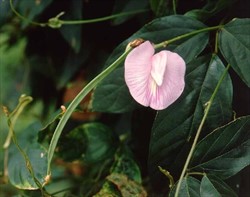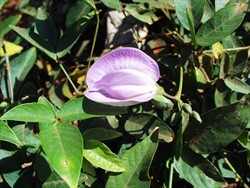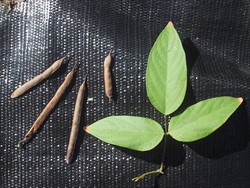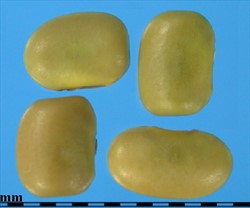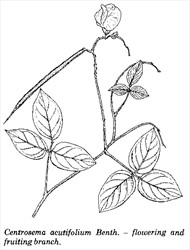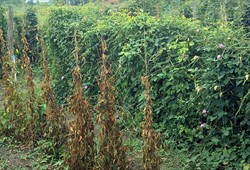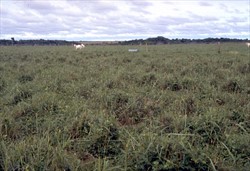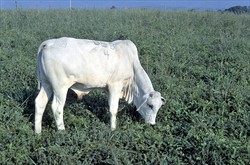Tropical Forages
Centrosema acutifolium Benth.
There are two distinct forms:
var. orinocense and var. matogrossense (both as 'nomen nudum', i.e. not validly described). The botanical variety, var. acutifolium, is not considered here since it is not known in the form of germplasm conserved ex situ.
None
Family: Fabaceae (alt. Leguminosae) subfamily: Faboideae tribe: Phaseoleae subtribe: Clitoriinae.
var. orinocense: Perennial, trailing-twining herb with slender pubescent stems, rooting at the nodes. Leaves trifoliolate, leaflets distinctly purplish when young; stipules deltoid-acuminate, pubescent; petioles and petiolules pubescent, reddish at their base; leaflets ovate to ovate-lanceolate, apically acuminate, puberulous to subglabrous on both surfaces; central leaflet symmetrical, 5‒8.5 cm long, 3‒3.5 cm wide; lateral leaflets somewhat smaller, asymmetrical. Inflorescence an axillary raceme with up to 24 flowers inserted by pairs along the rachis; peduncle conspicuously long, up to 19 cm, pubescent. Flower papilionate, subtended by a pair of ovate-acuminate bracteoles shorter than the calyx; calyx campanulate, 5-toothed, pilose, with short carinal and lateral teeth; petals light violet, standard orbicular-emarginate, 28‒35 mm × 32‒40 mm, pubescent outside. Pod linear, straight to slightly bent, up to 20 cm long, beaked, scabrid, with 10‒15 seeds, dehiscent. Seeds cylindrical, 5‒7 mm long, ca. 3 mm wide, greenish yellow with dark, fine mottles. 14,000‒20,000 seeds/kg.
var. matogrossense: Leaflets more elongated; peduncle not longer than 8 cm; bracteoles slightly longer than calyx; pod shorter, glabrous; seeds yellow, never mottled.
None reported
Native:
South America: Brazil (Amapá, Goiás, Mato Grosso do Sul, Minas Gerais, Paraná, Roraima, São Paulo, Tocantins); Colombia (e.); Venezuela (Amazonas, Bolivar)
var. orinocense: restricted to the Orinoco region in Colombia and Venezuela, between 4º and 6º N
var. matogrossense: occurs in an extended area in central-west Brazil
Soil requirements
Adapted to very acid, low to medium fertility soils, var. orinocense requiring light textured soils, and var. matogrossense preferring clayey, less well-drained soils. Tolerant of high levels of available Al and Mn.
Moisture
Sub-humid tropics with (800‒) 1,000‒2,500 (–3,000) mm rainfall/year with 3‒5 months dry season; drought tolerant.
Temperature
Warm season growth only. Average annual temperature in its native distribution is about 26 ºC.
Light
No significant shade tolerance.
Reproductive development
Late flowering, probably induced by short days.
Defoliation
Susceptible to heavy grazing.
Fire
No information available; probably low tolerance.
Guidelines for establishment and management of sown forages.
Establishment
Mechanical or acid scarification necessary to reduce the high level of hardseededness. Seed is normally sown at 3‒4 kg/ha; inoculation with an effective strain of Bradyrhizobium such as CIAT 3101 (= CB 3125 in Australia) is recommended.
Fertilizer
Responds well to P and K, with per hectare rates of 22 kg P, 30 kg K, 20 kg Mg and 20 kg S at sowing, and a maintenance dressing of half this every two years, being effective on a very acid infertile soil.
Compatibility (with other species)
Combines well with bunch grasses and other species that produce a more open stand, but there are positive experiences also with Urochloa humidicola cv. Llanero.
Companion species
Grasses: Andropogon gayanus, Urochloa brizantha, , Megathyrsus maximus.
Legumes: Stylosanthes capitata, S. guianensis.
Pests and diseases
Mainly var. matogrossense: Susceptible to Pseudomonas bacterial wilt and little leaf disease (phytoplasma); less susceptible to foliar blight (caused by Rhizoctonia solani) than . Cultivar Vichada of var. orinocense has shown to be susceptible to an unidentified, probably fungal, disease but there is variability in the germplasm collection.
Ability to spread
No significant spread.
Weed potential
Probably nil.
Dry matter
Rainy season: 1‒3 (‒5) t DM/ha/12 weeks.
Dry season: <1 t DM/ha/12 weeks.
Annual: >5 t DM/ha.
Animal production
Var. orinocense in mixture with Andropogon gayanus has produced daily LWG/steer of 530‒670 g in rainy season and sustained LW in dry season at a stocking rate of 1.5 steers/ha.
Var. matogrossense in association with or : increased milk yields of grazing Holstein cows by 15‒20% over grass alone.
2n = 22; autogamous; no breeding projects.
Moderate to low, e.g. in Colombia 150‒200 kg/ha handpicked, but potential yields up to 700 kg/ha. With its late flowering habit, early onset of the dry season can seriously interfere with seed production.
No information available.
- Adaptation to very acid, high Al and Mn, low-fertility soils.
- High forage quality.
- Potentially high seed production.
- Disease susceptibility of the only cultivar released so far.
- Low seed production in unsuitable environments.
Lascano, C.E. and Avila, P. (1991) Potencial de producción de leche en pasturas solas y asociadas con leguminosas adaptadas a suelos ácidos. Pasturas Tropicales 13(3):2–10. bit.ly/2QIx0Oz
Schultze-Kraft, R. (1992) Centrosema acutifolium Benth. In: Mannetje, L.’t and Jones, R.M. (eds) Plant Resources of South-East Asia No. 4. Forages. Pudoc Scientific Publishers, Wageningen, the Netherlands. p. 80–82. edepot.wur.nl/327785
Schultze-Kraft, R. and Clements, R.J. (eds). (1990) Centrosema: Biology, agronomy, and utilization. CIAT Publication No. 92. Centro Internacional de Agricultura Tropical (CIAT), Cali, Colombia. hdl.handle.net/10568/54383
Schultze-Kraft, R., Benavides, G. and Arias, A. (1987) Recolección de germoplasma y evaluación preliminar de Centrosema acutifolium. Pasturas Tropicales 9(1):12–20. bit.ly/3bnwAF4
CIAT 5568 (BRA 004821, CNPGC 0876, CPAC 1324, CPI 092884, CPI 094331, ILCA 12184) Selected in Colombia. Origin Brazil (-8.85 S, 48.3333 W, 290 m asl, rainfall 1,840 mm) var. matogrossense.
CIAT 15086 (BRA 012165) Selected in Colombia. Origin Colombia (4.9 N, 67.8667 W, 130 m asl, rainfall 2,766 mm) var. orinocense; disease resistant.
